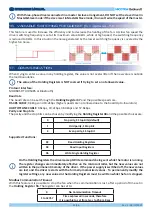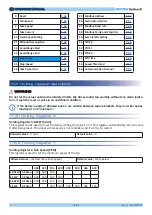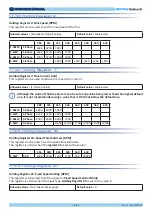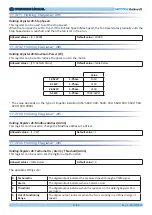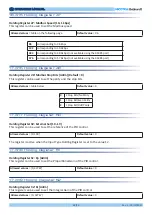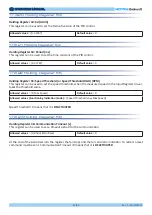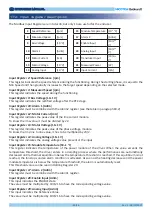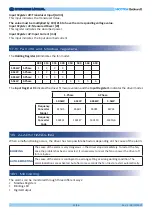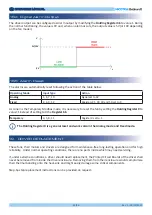
Rev. 1 - 05/10/2021
OPERATING MANUAL
OPERATING MANUAL
EN
EN
42/56
16. VARIABLE SWITCHING FREQUENCY (for 3-phase - 5.5 kW only)
17. COMMUNICATION
Protocol interface:
MODBUS RTU (RS485 or Bluetooth)
Baud rate
The baud rate can be set through the
Holding Register 47 and the possible speeds are:
RS-485 CABLE: 9.6kbps and 19.2kbps (higher speeds are not allowed due to the board Opto-Insulators)
UART OFFLINE CABLE: 9.6kbps, 19.2kbps, 38.4kbps and 57.6kbps.
Parity and Stop bits
The parity and the stop bits can be chosen by modifying the
Holding Register 48 and the possible choices are:
0
No parity, 2 Stop Bits (default)
1
Odd parity, 1 Stop Bit
2
Even parity, 1 Stop Bit
Supported Functions:
03
Read Holding Registers
04
Read Input Registers
06
Write Single Holding Register
Modbus Communication Timeout
With this feature it is possible to stop the fan when the communication is lost, after a period of time set in
the
Holding Register 56. The register can be set to:
0
No Communication Timeout
1 to 32767
Time expressed in seconds, therefore
it is possible to set from 1sec to 9h 6m 8 sec
With three-phase drivers connected in a master & slave arrangement, DO NOT set the slave driver in
Master&Slave mode: if the slave is set in Master&Slave mode, it runs at twice the speed of the master.
The value of the Holding Registers is NOT coerced if trying to set a not allowed value.
When trying to enter a value in any holding register, the value is not overwritten if the new value is outside
the load boundaries.
On the Holding Registers the drivers accept Write commands being sent while the motor is running.
The register changes are immediately effective on the microcontroller, but the new values are not
written in the permanent memory of the driver. If the power supply is switched off, the new values
are lost and the driver restarts with the formerly-memorized values. To permanently modify the
register settings, any new values in the Holding Registers must be written while the fan is stopped.
This feature is used to increase the efficiency and to decrease the heating of the fan. At slow fan speed the
driver switching frequency is set at its maximum value 14kHz, while at high speed, the switching frequency
is reduced to 8kHz. In this situation the noise generated by the lower switching frequency is covered by the
higher fan noise.















